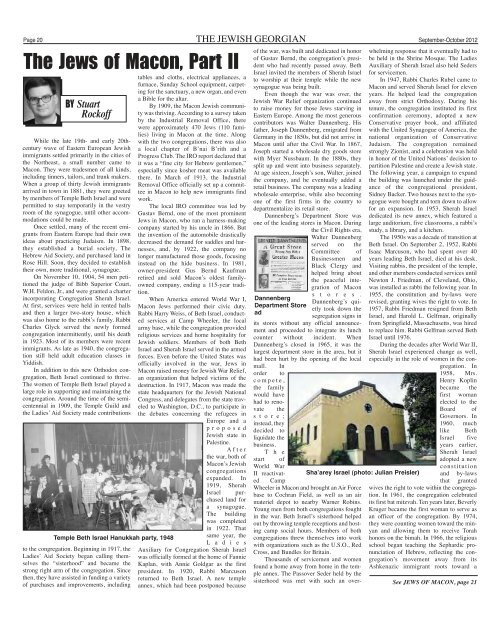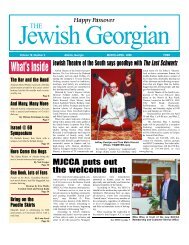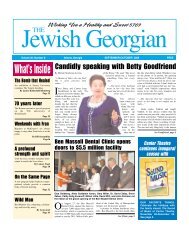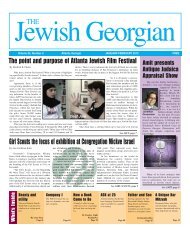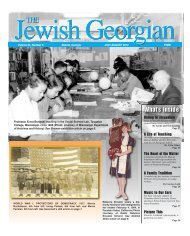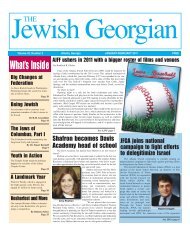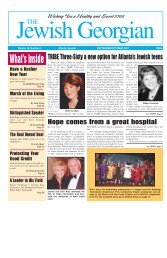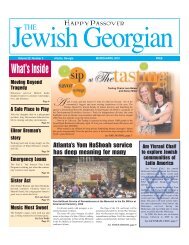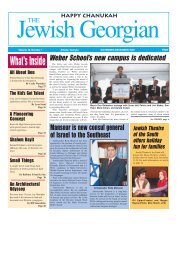mjcca news - The Jewish Georgian
mjcca news - The Jewish Georgian
mjcca news - The Jewish Georgian
You also want an ePaper? Increase the reach of your titles
YUMPU automatically turns print PDFs into web optimized ePapers that Google loves.
Page 20 THE JEWISH GEORGIAN September-October 2012<br />
<strong>The</strong> Jews of Macon, Part II<br />
BY<br />
Stuart<br />
Rockoff<br />
While the late 19th- and early 20thcentury<br />
wave of Eastern European <strong>Jewish</strong><br />
immigrants settled primarily in the cities of<br />
the Northeast, a small number came to<br />
Macon. <strong>The</strong>y were tradesmen of all kinds,<br />
including tinners, tailors, and trunk makers.<br />
When a group of thirty <strong>Jewish</strong> immigrants<br />
arrived in town in 1881, they were greeted<br />
by members of Temple Beth Israel and were<br />
permitted to stay temporarily in the vestry<br />
room of the synagogue, until other accommodations<br />
could be made.<br />
Once settled, many of the recent emigrants<br />
from Eastern Europe had their own<br />
ideas about practicing Judaism. In 1898,<br />
they established a burial society, <strong>The</strong><br />
Hebrew Aid Society, and purchased land in<br />
Rose Hill. Soon, they decided to establish<br />
their own, more traditional, synagogue.<br />
On November 10, 1904, 54 men petitioned<br />
the judge of Bibb Superior Court,<br />
W.H. Feldon, Jr., and were granted a charter<br />
incorporating Congregation Sherah Israel.<br />
At first, services were held in rented halls<br />
and then a larger two-story house, which<br />
was also home to the rabbi’s family. Rabbi<br />
Charles Glyck served the newly formed<br />
congregation intermittently, until his death<br />
in 1923. Most of its members were recent<br />
immigrants. As late as 1940, the congregation<br />
still held adult education classes in<br />
Yiddish.<br />
In addition to this new Orthodox congregation,<br />
Beth Israel continued to thrive.<br />
<strong>The</strong> women of Temple Beth Israel played a<br />
large role in supporting and maintaining the<br />
congregation. Around the time of the semicentennial<br />
in 1909, the Temple Guild and<br />
the Ladies’ Aid Society made contributions<br />
Temple Beth Israel Hanukkah party, 1948<br />
to the congregation. Beginning in 1917, the<br />
Ladies’ Aid Society began calling themselves<br />
the “sisterhood” and became the<br />
strong right arm of the congregation. Since<br />
then, they have assisted in funding a variety<br />
of purchases and improvements, including<br />
tables and cloths, electrical appliances, a<br />
furnace, Sunday School equipment, carpeting<br />
for the sanctuary, a new organ, and even<br />
a Bible for the altar.<br />
By 1909, the Macon <strong>Jewish</strong> community<br />
was thriving. According to a survey taken<br />
by the Industrial Removal Office, there<br />
were approximately 470 Jews (110 families)<br />
living in Macon at the time. Along<br />
with the two congregations, there was also<br />
a local chapter of B’nai B’rith and a<br />
Progress Club. <strong>The</strong> IRO report declared that<br />
it was a “fine city for Hebrew gentlemen,”<br />
especially since kosher meat was available<br />
there. In March of 1913, the Industrial<br />
Removal Office officially set up a committee<br />
in Macon to help new immigrants find<br />
work.<br />
<strong>The</strong> local IRO committee was led by<br />
Gustav Bernd, one of the most prominent<br />
Jews in Macon, who ran a harness-making<br />
company started by his uncle in 1866. But<br />
the invention of the automobile drastically<br />
decreased the demand for saddles and harnesses,<br />
and, by 1922, the company no<br />
longer manufactured those goods, focusing<br />
instead on the hide business. In 1981,<br />
owner-president Gus Bernd Kaufman<br />
retired and sold Macon’s oldest familyowned<br />
company, ending a 115-year tradition.<br />
When America entered World War I,<br />
Macon Jews performed their civic duty.<br />
Rabbi Harry Weiss, of Beth Israel, conducted<br />
services at Camp Wheeler, the local<br />
army base, while the congregation provided<br />
religious services and home hospitality for<br />
<strong>Jewish</strong> soldiers. Members of both Beth<br />
Israel and Sherah Israel served in the armed<br />
forces. Even before the United States was<br />
officially involved in the war, Jews in<br />
Macon raised money for <strong>Jewish</strong> War Relief,<br />
an organization that helped victims of the<br />
destruction. In 1917, Macon was made the<br />
state headquarters for the <strong>Jewish</strong> National<br />
Congress, and delegates from the state traveled<br />
to Washington, D.C., to participate in<br />
the debates concerning the refugees in<br />
Europe and a<br />
proposed<br />
<strong>Jewish</strong> state in<br />
Palestine.<br />
After<br />
the war, both of<br />
Macon’s <strong>Jewish</strong><br />
congregations<br />
expanded. In<br />
1919, Sherah<br />
Israel purchased<br />
land for<br />
a synagogue.<br />
<strong>The</strong> building<br />
was completed<br />
in 1922. That<br />
same year, the<br />
L a d i e s<br />
Auxiliary for Congregation Sherah Israel<br />
was officially formed at the home of Fannie<br />
Kaplan, with Annie Goldgar as the first<br />
president. In 1920, Rabbi Marcuson<br />
returned to Beth Israel. A new temple<br />
annex, which had been postponed because<br />
of the war, was built and dedicated in honor<br />
of Gustav Bernd, the congregation’s president<br />
who had recently passed away. Beth<br />
Israel invited the members of Sherah Israel<br />
to worship at their temple while the new<br />
synagogue was being built.<br />
Even though the war was over, the<br />
<strong>Jewish</strong> War Relief organization continued<br />
to raise money for those Jews starving in<br />
Eastern Europe. Among the most generous<br />
contributors was Walter Dannenberg. His<br />
father, Joseph Dannenberg, emigrated from<br />
Germany in the 1850s, but did not arrive in<br />
Macon until after the Civil War. In 1867,<br />
Joseph started a wholesale dry goods store<br />
with Myer Nussbaum. In the 1880s, they<br />
split up and went into business separately.<br />
At age sixteen, Joseph’s son, Walter, joined<br />
the company, and he eventually added a<br />
retail business. <strong>The</strong> company was a leading<br />
wholesale enterprise, while also becoming<br />
one of the first firms in the country to<br />
departmentalize its retail store.<br />
Dannenberg’s Department Store was<br />
one of the leading stores in Macon. During<br />
the Civil Rights era,<br />
Walter Dannenberg<br />
served on the<br />
Committee of<br />
Businessmen and<br />
Black Clergy and<br />
helped bring about<br />
the peaceful integration<br />
of Macon<br />
Dannenberg<br />
Department Store<br />
ad<br />
s t o r e s .<br />
Dannenberg’s quietly<br />
took down the<br />
segregation signs in<br />
its stores without any official announcement<br />
and proceeded to integrate its lunch<br />
counter without incident. When<br />
Dannenberg’s closed in 1965, it was the<br />
largest department store in the area, but it<br />
had been hurt by the opening of the local<br />
mall. In<br />
order to<br />
compete,<br />
the family<br />
would have<br />
had to renovate<br />
the<br />
s t o r e ;<br />
instead, they<br />
decided to<br />
liquidate the<br />
business.<br />
T h e<br />
start of<br />
World War<br />
II reactivated<br />
Camp<br />
Wheeler in Macon and brought an Air Force<br />
base to Cochran Field, as well as an air<br />
materiel depot to nearby Warner Robins.<br />
Young men from both congregations fought<br />
in the war. Beth Israel’s sisterhood helped<br />
out by throwing temple receptions and hosting<br />
camp social hours. Members of both<br />
congregations threw themselves into work<br />
with organizations such as the U.S.O., Red<br />
Cross, and Bundles for Britain.<br />
Thousands of servicemen and women<br />
found a home away from home in the temple<br />
annex. <strong>The</strong> Passover Seder held by the<br />
sisterhood was met with such an over-<br />
Shaʼarey Israel (photo: Julian Preisler)<br />
whelming response that it eventually had to<br />
be held in the Shrine Mosque. <strong>The</strong> Ladies<br />
Auxiliary of Sherah Israel also held Seders<br />
for servicemen.<br />
In 1947, Rabbi Charles Rubel came to<br />
Macon and served Sherah Israel for eleven<br />
years. He helped lead the congregation<br />
away from strict Orthodoxy. During his<br />
tenure, the congregation instituted its first<br />
confirmation ceremony, adopted a new<br />
Conservative prayer book, and affiliated<br />
with the United Synagogue of America, the<br />
national organization of Conservative<br />
Judaism. <strong>The</strong> congregation remained<br />
strongly Zionist, and a celebration was held<br />
in honor of the United Nations’ decision to<br />
partition Palestine and create a <strong>Jewish</strong> state.<br />
<strong>The</strong> following year, a campaign to expand<br />
the building was launched under the guidance<br />
of the congregational president,<br />
Sidney Backer. Two houses next to the synagogue<br />
were bought and torn down to allow<br />
for an expansion. In 1953, Sherah Israel<br />
dedicated its new annex, which featured a<br />
large auditorium, five classrooms, a rabbi’s<br />
study, a library, and a kitchen.<br />
<strong>The</strong> 1950s was a decade of transition at<br />
Beth Israel. On September 2, 1952, Rabbi<br />
Isaac Marcuson, who had spent over 40<br />
years leading Beth Israel, died at his desk.<br />
Visiting rabbis, the president of the temple,<br />
and other members conducted services until<br />
Newton J. Friedman, of Cleveland, Ohio,<br />
was installed as rabbi the following year. In<br />
1955, the constitution and by-laws were<br />
revised, granting wives the right to vote. In<br />
1957, Rabbi Friedman resigned from Beth<br />
Israel, and Harold L. Gelfman, originally<br />
from Springfield, Massachusetts, was hired<br />
to replace him. Rabbi Gelfman served Beth<br />
Israel until 1976.<br />
During the decades after World War II,<br />
Sherah Israel experienced change as well,<br />
especially in the role of women in the congregation.<br />
In<br />
1958, Mrs.<br />
Henry Koplin<br />
became the<br />
first woman<br />
elected to the<br />
Board of<br />
Governors. In<br />
1960, much<br />
like Beth<br />
Israel five<br />
years earlier,<br />
Sherah Israel<br />
adopted a new<br />
constitution<br />
and by-laws<br />
that granted<br />
wives the right to vote within the congregation.<br />
In 1961, the congregation celebrated<br />
its first bat mitzvah. Ten years later, Beverly<br />
Kruger became the first woman to serve as<br />
an officer of the congregation. By 1974,<br />
they were counting women toward the minyan<br />
and allowing them to receive Torah<br />
honors on the bimah. In 1966, the religious<br />
school began teaching the Sephardic pronunciation<br />
of Hebrew, reflecting the congregation’s<br />
movement away from its<br />
Ashkenazic immigrant roots toward a<br />
See JEWS OF MACON, page 21


